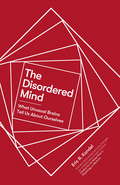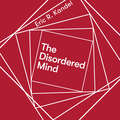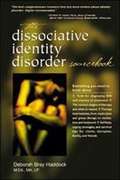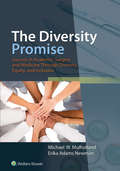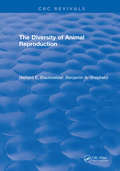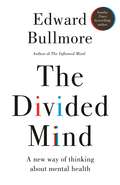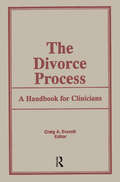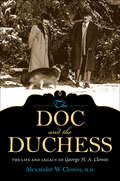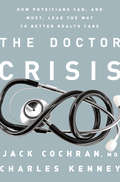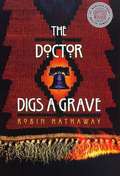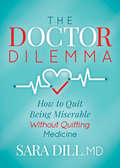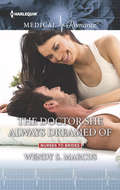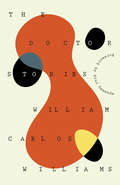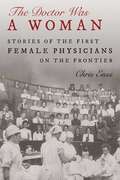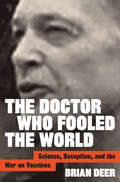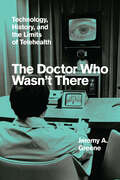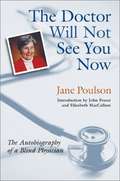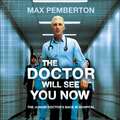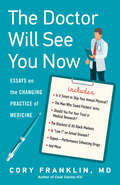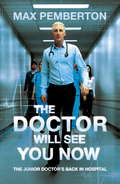- Table View
- List View
The Disordered Mind: What Unusual Brains Tell Us About Ourselves
by Eric R. KandelNeurological and psychiatric disorders have long been regarded as fundamentally different, depending on whether they appear to affect the brain or the mind. In reality, the brain and the mind are inseparable. Both types of disorder can affect every aspect of brain function: from perception, action, memory and emotion to empathy, social interaction, attention and consciousness. It is easy to view brain disorders as simply tragic or frightening. However, studying where these functions go wrong provides a window on the workings of the healthy brain, and makes it more likely that scientists and clinicians will be able to develop effective treatments or preventative strategies. As individuals, and as a society, we are also able to better empathise with people with disorders of the mind.Building on his pioneering research, Eric R. Kandel illustrates how breakthrough studies of brain disruptions can deepen our understanding of thought, feeling, behaviour, memory and creativity, and perhaps in the future will transform medical care and lead to the development of a unified theory of mind.
The Disordered Mind: What Unusual Brains Tell Us About Ourselves
by Eric R. Kandel'[Kandel's discoveries] have truly changed our understanding of brain function' - Citation for the Nobel Prize in Physiology or Medicine'[Eric Kandel is] one of the preeminent neuroscientists in the world' - Sue Halpern, The New York Review of Books Highly commended at the British Medical Association Book Awards 2019Neurological and psychiatric disorders have long been regarded as fundamentally different, depending on whether they appear to affect the brain or the mind. In reality, the brain and the mind are inseparable. Both types of disorder can affect every aspect of brain function: from perception, action, memory and emotion to empathy, social interaction, attention and consciousness. It is easy to view brain disorders as simply tragic or frightening. However, studying where these functions go wrong provides a window on the workings of the healthy brain, and makes it more likely that scientists and clinicians will be able to develop effective treatments or preventative strategies. As individuals, and as a society, we are also able to better empathise with people with disorders of the mind.Building on his pioneering research, Eric R. Kandel illustrates how breakthrough studies of brain disruptions can deepen our understanding of thought, feeling, behaviour, memory and creativity, and perhaps in the future will transform medical care and lead to the development of a unified theory of mind.
The Dissociative Identity Disorder Sourcebook (Sourcebooks)
by Deborah HaddockFrom Eve to Sybil to Truddi Chase, the media have long chronicled the lives of people with dissociative identity disorder (DID), formerly known as multiple personality disorder. The Dissociative Identity Disorder Sourcebook serves as a much-needed bridge for communication between the dissociative individual and therapists, family, and friends who also have to learn to deal with the effects of this truly astonishing disorder.
The Distant Healing Handbook: How to send healing to people, animals, the environment and global trouble spots
by Jack AngeloTHE DISTANT HEALING HANDBOOK is an important book from the UK's leading healing teacher, Jack Angelo. Jack explains that we all have it in our power to take action, to reach out and help people, places and animals who are in need. Extraordinary case histories reveal the beneficial effect distant healing can have. Step-by-step, using over 60 easy-to-follow exercises, Jack shows you how to access your own distant healing power and harness your love and energy for the good of others. THE DISTANT HEALING HANDBOOK will enable you to: Sense your energy field and send healing to people at any distance; Work on your own or with a group or healing circle; Learn advanced, astral level healing; Work with the environment, plants and animals; Send light to trouble spots and disaster areas around the world; Practise unconditional love and bring healing into your everyday life. THE DISTANT HEALING HANDBOOK is a book everyone can use, whether you already have a healing gift or whether you simply want to learn how to send healing and make a difference to a loved one, a pet or to the world we live in.
The Distant Healing Handbook: How to send healing to people, animals, the environment and global trouble spots
by Jack AngeloTHE DISTANT HEALING HANDBOOK is an important book from the UK's leading healing teacher, Jack Angelo. Jack explains that we all have it in our power to take action, to reach out and help people, places and animals who are in need. Extraordinary case histories reveal the beneficial effect distant healing can have. Step-by-step, using over 60 easy-to-follow exercises, Jack shows you how to access your own distant healing power and harness your love and energy for the good of others. THE DISTANT HEALING HANDBOOK will enable you to: Sense your energy field and send healing to people at any distance; Work on your own or with a group or healing circle; Learn advanced, astral level healing; Work with the environment, plants and animals; Send light to trouble spots and disaster areas around the world; Practise unconditional love and bring healing into your everyday life. THE DISTANT HEALING HANDBOOK is a book everyone can use, whether you already have a healing gift or whether you simply want to learn how to send healing and make a difference to a loved one, a pet or to the world we live in.
The Divergent Channels - Jing Bie: A Handbook for Clinical Practice and Five Shen Nei Dan Inner Meditation
by David TwickenRooted in the Su Wen and Ling Shu, Dr. Twicken's book integrates Chinese and Taoist medical philosophy, theories, and principles to clearly demonstrate that the Divergent Channels are an essential aspect of the clinical practice of acupuncture. He takes a step-by-step approach to assist practitioners in 'working out' the channels, and shows how this versatile channel system can be used in any acupuncture treatment. Twicken also includes instruction on Five Shen Nei Dan inner meditation to help practitioners gain a more profound emotional and spiritual understanding. With case studies and reference to the classic texts throughout, this book provides a complete resource that will help clinicians understand and use the Divergent Channels in clinical practice. An accessible and comprehensive account of the Divergent Channel system, this book will be a valuable addition to the shelves of students and practitioners of acupuncture and Chinese medicine; taiji and qigong practitioners; and anyone with an interest in Taoist practice.
The Diversity Promise: Success in Academic Surgery and Medicine Through Diversity, Equity, and Inclusion
by Michael W. MulhollandIssues of diversity, equity, and inclusion are of utmost importance in today’s medical schools, and the University of Michigan is at the forefront of effecting change in this key area of medical education. Drs. Michael Mulholland and Erika Newman and the Department of Surgery at the University of Michigan School of Medicine developed the Michigan Promise with the goal of achieving better results and assisting other schools of medicine to make progress in this area, as well. The Diversity Promise: Success in Academic Surgery and Medicine Through Diversity, Equity, and Inclusion discusses the structure and implementation of this innovative program—information that is easily transferrable to any department in a school of medicine.
The Diversity of Animal Reproduction
by Richard E. BlackwelderThis book is primarily a monograph of the reproductive diversity among animals, including protozoans. This diversity is listed for each group in Chapter 6; it is cross-listed by process in chapter 7.
The Divided Mind: A new way of thinking about mental health
by Professor Edward Bullmore"A tour de force of science and history writing by one of our most important psychiatric leaders." John H. Krystal M.D., Professor of Psychiatry, Yale University"A riveting read - told through the eyes of one of the world's most accomplished and compassionate psychiatrists." Professor Karl J. Friston, Queen Square Institute of Neurology, University College London"Edward Bullmore has given us a profoundly important book for family members, students, and professionals interested in mental health and mental illness." Dr. Thomas R Insel, Former Director of U.S. National Institute of Mental Health"Perhaps if more politicians read this book and understood what goes wrong in the minds of people with schizophrenia, they might be more willing to devote sufficient resources to get people better." Sir Robin MacGregor Murray, Professor of Psychiatric Research at the Institute of Psychiatry, King's CollegeFor centuries, mental and physical health have been divided and disorders of the mind and body have been treated as if they were poles apart. This deep-rooted division has shaped medicine, psychiatry, and society. But what if this mind/body split is not only outdated - but dangerously misleading?In this groundbreaking follow-up to his bestselling The Inflamed Mind, psychiatrist and neuroscientist Edward Bullmore challenges one of medicine's most enduring assumptions.Through the lens of schizophrenia - perhaps the most misunderstood of all psychiatric disorders - Bullmore explores what he calls "the original schism" and the under-examined history of psychiatry itself.Taking readers on a gripping journey through the evolving science of schizophrenia, illuminated by his personal experiences as a researcher and clinician, Bullmore lifts the lid on psychiatry's dark past. He highlights how the horror of the Nazi eugenics programme magnified a split between brain and mind theories which persists to this day. And he expertly introduces some of the new science that is building the case for a radical rethink of how we understand - and treat - so-called mental illness in the 21st century.The Divided Mind shows us why and how we can now change our minds about the origins of one of the most mysterious and stigmatised disorders in medicine. It challenges us all to escape from our history to a more joined-up future for mental and physical health.
The Divorce Process: A Handbook for Clinicians
by Craig EverettProfessionals who work with divorcing couples and their families will be inspired by this important book on effective clinical assessment and intervention. The book blends a variety of expert contributions--descriptive, theoretical, and empirical--into a practical handbook that focuses on resources for dealing with the anger and pain of parting spouses and disrupted childhoods. A rich array of clinically useful materials is provided. The book covers background theory, marital interaction, the definition of clinical dysfunctions in children of divorce, specific clinical features of childhood developmental levels, post-divorce reorganization, and models of group work.
The Doc and the Duchess: The Life and Legacy of George H. A. Clowes
by Alexander W. ClowesAn “informative and enlightening” biography of a scientist who helped bring insulin to the world, and went on to become a prominent philanthropist (The Franklin Daily Journal).George Henry Alexander Clowes was a pivotal figure in the development of the insulin program at the Eli Lilly Company. Through his leadership, scientists and clinicians at Lilly and the University of Toronto created a unique international team to develop and purify insulin and take the production of this life-saving agent to an industrial scale.This biography, written by his grandson, presents his scientific achievements, and also takes note of his social and philanthropic contributions, which he shared with his wife, Edith. It tells the story of Clowes from his childhood in late Victorian England to his death at Woods Hole on Cape Cod in 1958. Educated in England and Germany, Clowes came to America to join a startup laboratory in Buffalo, where he conducted basic research on cancer and applied research on other disease-related problems. Assuming the position of head of research at Lilly, Clowes was at the center of one of the great discoveries that changed the course of medical history and offered new life to millions of individuals with diabetes and other metabolic disorders. Clowes was also instrumental in the development of other commercial pharmaceutical advances. Devoted to a number of philanthropic causes, Clowes and Edith contributed greatly to the cultural life of his adopted country, a contribution that continues to this day.
The Doctor & the Runaway Heiress
by Marion LennoxDr Darcy Rochester is horrified when `doctor' Ally Westruther sets up her massage business next door. But why does such a talented doctor refuse to practise medicine as well as massage? Why doesn't such a skilled worker have enough money to eat? and why does such a beautiful, caring, passionate woman want nothing to do with love?
The Doctor Crisis: How Physicians Can, and Must, Lead the Way to Better Health Care
by Charles Kenney Jack CochranCalming fears, alleviating suffering, enhancing and saving lives?this is what motivates doctors virtually every single day. When the structure and culture in which physicians work are well aligned, being a doctor is a most rewarding job. But something has gone wrong in the physician world, and it is urgent that we fix it. Fundamental flaws in the US health care system make it more difficult and less rewarding than ever to be a doctor. The convergence of a complex amalgam of forces prevents primary care and specialty physicians from doing what they most want to do: Put their patients first at every step in the care process every time. Barriers include regulation, bureaucracy, the liability burden, reduced reimbursements, and much more. Physicians must accept the responsibility for guiding our nation toward a better health care delivery system, but the pathway forward?amidst jarring changes in our health care system?is not always clear. In "The Doctor Crisis," Dr. Jack Cochran, executive director of The Permanente Federation, and author Charles Kenney show how we can improve health care on a grassroots level, regardless of political policy disputes, by improving conditions for physicians and asking them to take on broader accountability; by calling on physicians to be effective leaders as well as excellent clinicians. The authors clarify the necessary steps required to enable physicians to focus on patient care and offer concrete ideas for establishing systems that place patientsOCO needs above all else. Cochran and Kenney make a compelling case that fixing the doctor crisis is a prerequisite to achieving access to quality and affordable health care throughout the United States. "
The Doctor Digs A Grave (Dr. Fenimore Mysteries)
by Robin HathawayHathaway introduces sleuth cardiologist Dr. Andrew Fenimore, whose expert medical knowledge helps unravel the mysterious death of a Lenape woman. When Fenimore spots a street kid named Horatio unsuccessfully trying to bury his dead cat in a public park on Philadelphia's affluent Society Hill, he befriends the youth and offers to help him lay his pet to rest in what is rumored to be an ancient burial ground of the Lenape. Descendants of this East Coast tribe still live in the eastern Pennsylvania and New Jersey area. While burying the animal, the doctor and Horatio stumble upon the body of a young girl who is buried in an upright position facing east as is traditional with the Lenape. From this curious discovery, Hathaway's novel weaves the forgotten culture of this tribe, the doctor's unconventional avocation as a P.I., and a cast of lovable but eccentric characters into a well-crafted tale of suspense. -Amazon.com
The Doctor Dilemma: How to Quit Being Miserable Without Quitting Medicine
by Sara DillThe Doctor Dilemma is an easy-to-read book for busy physicians who are struggling with burnout, unhappiness, and career dissatisfaction, and may even be wondering if they made a mistake becoming a doctor. Currently over 50% of physicians across all medical specialties are reporting symptoms of increasing stress and burnout. Sara Dill, MD has been there. She knows how painful it is to secretly wonder if all those years of school and training were a mistake. The Doctor Dilemma reminds doctors why they decided to go into medicine in the first place and helps them outline what their dream job looks like. This timely helper, written by a physician and certified life coach, outlines the tools and steps doctors can take to start feeling better, reverse burnout, and create the dream medical career and work-life balance they want. It’s time for doctors to become the happy and successful healers they always wanted to be.
The Doctor She Always Dreamed Of
by Wendy S. MarcusDare she dream of forever? Nurse Kira Peniglatt isn't in the market for a happy-ever-after. Between her busy job and caring for her sick mother, she's learned the hard way that she comes with too much baggage for most men to handle. Except Dr. Derrick Limone isn't most men-he's caring, funny, outrageously sexy...and he understands that she comes as a package deal. One sizzling kiss from Derrick later, and suddenly Kira hopes... Has she finally found the man she's always dreamed of?
The Doctor Stories
by Atul Gawande William Carlos Williams William Eric WilliamsA new edition of one of the best books ever written about being a doctor: writing as aware and memorable as Chekhov’s. The Doctor Stories collects thirteen of Williams’s stories (direct accounts of his experiences as a doctor), six related poems, and a chapter from his autobiography that connects the world of medicine and writing, as well as a new preface by Atul Gawande, an introduction by Robert Coles (who put the book together), and a final note by Williams’s son (also a doctor), about his famous father. The writings are remarkably direct and freshly true. As Atul Gawande notes, “Reading these tales,you find yourself in a conversation with Williams about who people really are—who you really are. Williams recognized that, caring for the people of his city, he had a front-row seat to the human condition. His writing makes us see it and hear it and grapple with it in all its complexities. That is his lasting gift.”
The Doctor Was a Woman: Stories of the First Female Physicians on the Frontier
by Chris Enss"No women need apply." Western towns looking for a local doctor during the frontier era often concluded their advertisements in just that manner. Yet apply they did. And in small towns all over the West, highly trained women from medical colleges in the East took on the post of local doctor to great acclaim. In this new book, author Chris Enss offers a glimpse into the fascinating lives of ten amazing women, including the first female surgeon of Texas, the first female doctor to be convicted of manslaughter in an abortion-related maternal death, and the first woman physician to serve on a State Board of Health.
The Doctor Who Fooled the World: Science, Deception, and the War on Vaccines
by Brian DeerFrom San Francisco to Shanghai, from Vancouver to Venice, controversy over vaccines is erupting around the globe. Fear is spreading. Banished diseases have returned. And a militant "anti-vax" movement has surfaced to campaign against children's shots.But why?In The Doctor Who Fooled the World, award-winning investigative reporter Brian Deer exposes the truth behind the crisis. Writing with the page-turning tension of a detective story, he unmasks the players and unearths the facts. Where it began. Who was responsible. How they pulled it off. Who paid.At the heart of this dark narrative is the rise of the so-called "father of the anti-vaccine movement": a British-born doctor, Andrew Wakefield. Banned from medicine, thanks to Deer's discoveries, he fled to the United States to pursue his ambitions, and now claims to be winning a "war."In an epic investigation spread across fifteen years, Deer battles medical secrecy and insider cover-ups, smear campaigns and gagging lawsuits, to uncover rigged research and moneymaking schemes, the heartbreaking plight of families struggling with disability, and the scientific scandal of our time.
The Doctor Who Wasn't There: Technology, History, and the Limits of Telehealth
by Jeremy A. GreeneThis gripping history shows how the electronic devices we use to access care influence the kind of care we receive.The Doctor Who Wasn’t There traces the long arc of enthusiasm for—and skepticism of—electronic media in health and medicine. Over the past century, a series of new technologies promised to democratize access to healthcare. From the humble telephone to the connected smartphone, from FM radio to wireless wearables, from cable television to the “electronic brains” of networked mainframe computers: each new platform has promised a radical reformation of the healthcare landscape. With equal attention to the history of technology, the history of medicine, and the politics and economies of American healthcare, physician and historian Jeremy A. Greene explores the role that electronic media play, for better and for worse, in the past, present, and future of our health. Today’s telehealth devices are far more sophisticated than the hook-and-ringer telephones of the 1920s, the radios that broadcasted health data in the 1940s, the closed-circuit televisions that enabled telemedicine in the 1950s, or the online systems that created electronic medical records in the 1960s. But the ethical, economic, and logistical concerns they raise are prefigured in the past, as are the gaps between what was promised and what was delivered. Each of these platforms also produced subtle transformations in health and healthcare that we have learned to forget, displaced by promises of ever newer forms of communication that took their place. Illuminating the social and technical contexts in which electronic medicine has been conceived and put into practice, Greene’s history shows the urgent stakes, then and now, for those who would seek in new media the means to build a more equitable future for American healthcare.
The Doctor Will Not See You Now
by Jane PoulsonA spiritual autobiography by Dr. Poulson takes the reader by the arm through the story of her career as a sighted medical scientist who became blind in the first year of her professional career. No reader will fail to be astonished and inspired by her accomplishments and optimism.
The Doctor Will See You Now
by Max PembertonThe doctor is back again and on the wards! Now in his third year as junior doctor, Max looks and sounds the part. But this time around, things are not at all as he expected ...The junior doctor ... back on the wards. After a year on the streets treating outreach patients, Max Pemberton is back in the relative comfort of hospital. This time running between elderly care and the dementia clinic to A&E and outpatients. No longer inexperienced (Max and his doctor friends can now tell when someone is actually dead), they are on the front line of patient care for better or worse. In the midst of an NHS still under threat (some things never change) there are committed and caring doctors, big issues, hope, frustration, huge societal changes affecting the entire health system as well as the general drama of everyday life in a big hospital, from biscuit wars to resus. It's not like television, this is real - there are no easy answers - but The Doctor Will See You Now will give you hope that there are enough good doctors asking the questions.(P) 2020 Hodder & Stoughton Ltd
The Doctor Will See You Now: Essays on the Changing Practice of Medicine
by Cory FranklinIs it smart to skip your annual physical? Should you put your trust in medical research? Is "low T" an actual disease? This book examines these questions and more you've always wondered about in more than fifty essays on the practice of medicine. The Doctor Will See You Now is a quirky and eclectic collection of short pieces that explore the evolving patient-physician relationship; famous doctors and notorious patients; surprising hospital practices and the future of health care; medical reporting, research, ethics, drugs, and money; and the brave new world of neurology. Author Cory Franklin, MD, spent twenty-five years as the director of intensive care at Cook County Hospital in Chicago. Here he brings readers into his office to discuss the surprising ways the practice of medicine is changing today.
The Doctor Will See You Now: The Junior Doctor's Back In Hospital
by Max PembertonThe doctor is back again and on the wards! Now in his third year as junior doctor, Max looks and sounds the part. But this time around, things are not at all as he expected ...The junior doctor ... back on the wards. After a year on the streets treating outreach patients, Max Pemberton is back in the relative comfort of hospital. This time running between elderly care and the dementia clinic to A&E and outpatients. No longer inexperienced (Max and his doctor friends can now tell when someone is actually dead), they are on the front line of patient care for better or worse. In the midst of an NHS still under threat (some things never change) there are committed and caring doctors, big issues, hope, frustration, huge societal changes affecting the entire health system as well as the general drama of everyday life in a big hospital, from biscuit wars to resus. It's not like television, this is real - there are no easy answers - but The Doctor Will See You Now will give you hope that there are enough good doctors asking the questions.
The Doctor Will See You Now: The Junior Doctor's Back In Hospital
by Max PembertonThe doctor is back again and on the wards! Now in his third year as junior doctor, Max looks and sounds the part. But this time around, things are not at all as he expected ...The junior doctor ... back on the wards. After a year on the streets treating outreach patients, Max Pemberton is back in the relative comfort of hospital. This time running between elderly care and the dementia clinic to A&E and outpatients. No longer inexperienced (Max and his doctor friends can now tell when someone is actually dead), they are on the front line of patient care for better or worse. In the midst of an NHS still under threat (some things never change) there are committed and caring doctors, big issues, hope, frustration, huge societal changes affecting the entire health system as well as the general drama of everyday life in a big hospital, from biscuit wars to resus. It's not like television, this is real - there are no easy answers - but The Doctor Will See You Now will give you hope that there are enough good doctors asking the questions.
